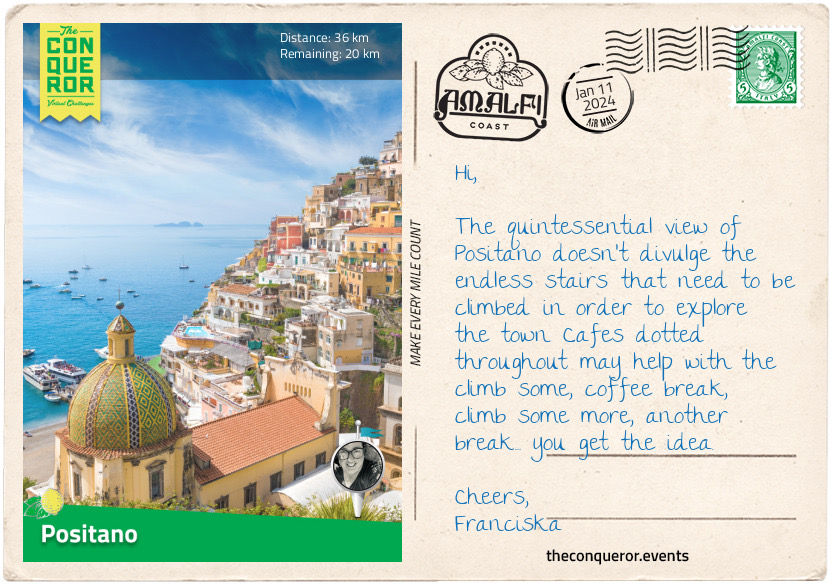Amalfi Coast Challenge: Stage 6
- Franciska Neuhäuser
- Jan 10, 2024
- 3 min read
Updated: Jan 16, 2024

Perched up in the hills overlooking the sea is the very popular town of Positano. The pastel coloured buildings spilling down the hills give the impression of a dusty rose ombre layered cake. Yet the narrow roads through and around the town with their curves and sharp turns are reminiscent of a Grand Prix Formula 1 track. And then, there's all the stairs tucked amongst the buildings leading up or down through narrow alleyways.
There are two main beaches in Positano. Each one has a private and public section. The private section is defined by rows of neatly lined lounge chairs, each one with their own umbrella and a fee to hire. Whereas the public section is breely accessible without lounges or any service.
Positano thrived and declined many times throughout history. It endured destruction from a tsunami in 13th century; attacks from the Ottomans in 15th century; gained wealth through maritime trading in 18th century; and had its final decline in 19th century following Italy's unification and opening of other commercial routes. As a result, many emigrated to the United States and Positano was reduced to a small fishing village.
However, in mid-20th century it was launched onto the world stage when John Steinbeck, and American author, drove from Rome to Positano to escape the summer heat. He was so enchanted by the location that he wrote a lengthy essay about the town and had it published in Harper's Bazaar in 1953. So began Positano's economic turnaround.
At the heart of the town is Chiesa di Santa Maria Asunta, a 13th century church with a majolica-tiled dome. Tucked away amongst narrow streets it is accessibly by two sets of stairs and known for its Byzantine Black Madonna and Child icon. According to legend, the icon was once carried by a pirate ship sailing in the nearby waters of Positano. When a furious storm hit, with little chance of survival, the pirates heard the cries of Many from the icon say "lay me down". Taking that as a sign, the pirates turned the bow towards land and miraculously arrived safely in harbour. Once ashore, they handed the icon to the local people who then built the church in her honour.
Now let's talk about food. The Campania region encompasses the Amalfi Coast and it is the birthplace of Campania's Buffalo Mozzarella, a cheese made from indigenous Buffalo's milk. The curd, cut by hand, is made into small balls with a creamy texture and tangy sweet flavour. The most delightful way to enjoy the flavour of this particular cheese is in a Caprese Salad.
On a dinner plate, layer sliced vine-ripened tomatoes, with sliced buffalo mozzarella, topped with fresh basil leaves. Drizzle extra-virgin olive oil and aged-balsamic vinegar, and season with salt and pepper. Bon appetito!!
So I *may* have over done things. The district nurse yesterday appeared somewhat concerned with my wound. Not concerned enough to send me direct to a GP, but concerned enough to suggest we re-assess at the next visit (on Saturday). So I decided to slow down and take a rest day yesterday.
Today I was itching to do at least some form of exercise and was delighted to discover a "Bend" challenge series; promising to improve one's flexibility. I completed the whole 23 minutes: warm up, followed by three tracks targeting three different areas, and a cool down. This felt MUCH better than trying to do Yoga; and I am confident that these releases will help me feel more comfortable when I next attempt some Yoga.









Comments